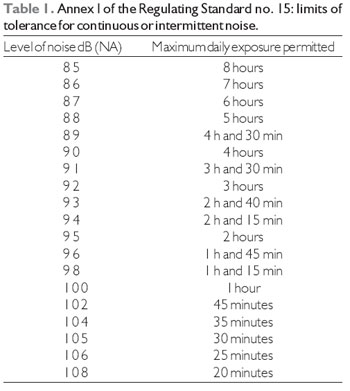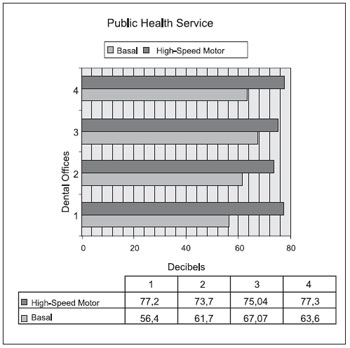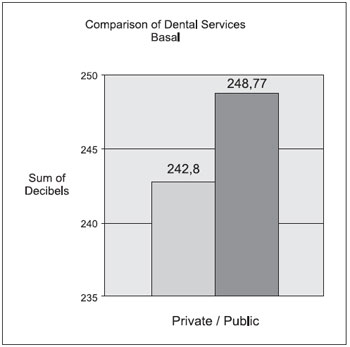 |
746 |
|
| Year: 2011 Vol. 15 Num. 1 - Jan/Mar - (13º)
|
|
 |
| Section:
Original Article
|
|
|
|
|
| Can Noise in Dental Clinic Produce Hearing Loss? |
|
| Author(s): |
| Edmir Américo Lourenço1, Janaína Medina da Rocha Berto2, Sávio Butignolli Duarte3, João Paulo Martins Greco4.
|
|
|
| Key words: |
| occupational noise, work environment, odontology, odontological instruments, hearing loss. |
|
|
 |
| Abstract: |
Introduction: The sensorial hearing loss and irreversible noise induced is the major evitable occupational cause of hearing loss worldwide. The dentists are health professionals exposed to noises from equipment in their clinics and may suffer hearing losses. Objective: Measure the noise intensities emitted by the high rotation motors (mar) used in public and private dental clinics, check whether they are harmful for the human ear and compare the results obtained in such services. Method: Serial, retrospective study with measures of the noise intensities in dBNA with a decibelimeter Minipa MSL-1352C, USA, in four dental clinics of the public service and four private clinics in Jundiaí-SP, initially from the basal environment noise in each clinic, during five minutes and then from the noise emitted by the high rotation motor (mar) in operation during five minutes to obtain the averages. Results: Public clinics: 1)basal medium=56.4dB;mar=77.2dB. 2)basal medium=61.7dB;mar=73.7dB. 3)basal medium=61.07dB;mar=75.04dB. 4)basal medium=63.6dB;mar=77.3dB. Private clinics: 1)basal medium=60,7dB;mar=79,1dB. 2)basal=60,7dB;mar=83,1dB. 3)basal=58,4dB;mar=75,5dB. 4)basal=63dB;mar=76dB. Conclusion: The intensities measured of noise emitted by high rotation motors used in public and private dental clinics are below the limits harmful to the auditory health. In the public service, the basal medium noise intensity is higher than that of the private clinics, however the one of the high rotation motors is higher in the private clinics.
|
|
 |
INTRODUCTION
The noise induced hearing loss (NIHL) is a neurosensorial hearing loss predominantly cochlear and of irreversible. This disease occurs due to a prolonged history of high intensity noise exposure and has a gradual and progressive evolution. The hearing loss occurs when it is not an impossibility of sound reception by lesion of the hair cells of the cochlea and starts in high frequencies, generally in 4000 Hz (four kilohertz). After noise exposure, the hearing loss tends to stabilize.
The NIHL achieves acute frequencies and the main difficulties include hearing bells and telephone calls. With the further advance of the disease, there comes difficulties in all frequencies, therefore the diagnosis is many times delayed.
This is the occupational disease of highest incidence and the major evitable cause of hearing loss worldwide, according to LOPES FILHO and CAMPOS (1). The exposed individuals periodical controls and the sound intensity levels permitted by 8 hours of daily exposure to the noise are maximally of 85 decibels and are well regulated according to Annex I of the regulating standards of numbers 7 and 15 of the Brazilian Labor Law as provided in Table 1 (2, 3).
The dentists are health professionals exposed in their offices to several noises produced and emitted by high and low rotation pens, suction tube, compressor, spitter, straight piece, photopolymerizer, autoclave and air-conditioning, however, the first ones are considered to have a major harmful potential to the human ear. Therefore, different studies have analyzed the relationship between the intensity of the noises in the dental office, the professional hours, the time of professional activity and the hearing loss in these professionals (4). What we confirm in most of them is that even exposed to sound intensity levels lower than 85 decibels, but with a time of professional exercise over five years, they present with hearing losses (5, 6).
To prevent the unleashing or aggravation of occupational hearing loss an annual audiologic control through at least one audiometry, in addition to individual protection should be performed. Table 1 below shows Annex I of the Regulating Standard number 15 that establishes the tolerance limits for continuous and intermittent noise (3).
The objectives of this work are: 1) measuring the noise intensities in public and private dental offices, from pens driven by high rotation engine and the environment basal noise, checking whether these have harmful intensities for the human ear; 2) comparing the results obtained between the public and private service.
METHOD
The measurement places were dental offices of Health Basic Units (UBS) or other public services and private offices in Jundiaí, State of São Paulo, Brazil, in which the professional, the assistant and the patient are daily exposed after contact and agreement of the participants. Received at SISNEP, the work was approved by the Ethics Committee in Research of the Teaching Institution under number 314/2008. The noise intensity measurement was made in four dental offices of the public health system and at four private offices. For measurement, we used a Minipa® decibelimeter, model MSL-1352C, from USA, set up as follows: Slow response time that measured the level of noise in decibels (dBNA), with scale of 30 to 130 dB, for a period of five minutes at a distance of twenty centimeters from the pen and the high rotation engine, of the Dabi Atlante®, Kavo®, and Micro Dente ®, used by different professionals in their offices. The environmental intensity was initially measured in each office, during five minutes and this value was called Basal. Then we carried out the measurement of the intensity of the noise emitted by the above mentioned equipment, also for five minutes. In these two scenarios, the average in decibels of the noise intensity was calculated.
No statistical analysis of the results was carried out due to the type of graphic register of the decibelimeter used and the fact that the main objective of the study was that of determining if the intensities measured would be lesive for the human ear.
RESULTS
Dental offices of the public health system of Jundiaí (Graphic 1):
1. Basal, with environmental noise (conversation): average of 56.4 dB. High rotation engine (Dabi Atlante®, time of use of four and a half years, time of exposure of 3 hours a day), average of 77.2 dB;
2. Basal, with environmental noise (conversation, fan and consultation at the chair beside): average of 61.7 dB. High rotation engine (Dabi Atlante®, time of use of four years, time of exposure of 4 hours a day), average of 73.7 dB;
3. Basal, with environmental noise (conversation): average of 67.1 dB. High rotation engine (Kavo®, time of indefinite use, time of exposure, one third of the professional hours), average of 75.0 dB;
4. Basal, with environmental noise (radio and fan): average of 63.6 dB. High rotation engine (Kavo®, time of use longer than one year, indefinite exposure time), average of 77.3 dB.
Private dental offices of Jundiaí (Graphic 2):
1. Basal, with environmental noise (conversation, suction tube, ambient noise): average of 60.7 dB. High rotation engine (Kavo®, time of use of one year, time of exposure of three hours a day), average of 79.1 dB;
2. Basal, with environmental noise (conversation, suction tube, ambient noise): average of 60.7 dB. High rotation engine (Kavo®, time of use of one year, time of exposure of three hours a day), average of 83.1 dB;
3. Basal, with environmental noise (Air-conditioning, suction tube and conversation): average of 58.4 dB. High rotation engine (Kavo®, time of use of two years, time of exposure of three hours a day), average of 75.5 dB;
4. Basal, with environmental noise (environmental noise, conversation, suction tube): average of 63.0 dB. High rotation engine (Micro Dente®, time of use of five years, time of exposure of 4 hours a day), average of 76.0 dB.

DISCUSSION
The concern with the hearing losses of occupational origin is due to the fact that this disease is the occupational disease of the highest incidence and evitable cause of hearing loss worldwide. After the noise exposure is over it tends to stabilize, and the detection is its most effective preventive action. Noises emitted by household appliances that caused the authorities' concern in the past as for the maintenance of the auditory health in the houses, restaurants and other places where such appliances are used have been reduced with technological enhancement (7). Therefore, the old high rotation engines of dental use also presented a sound limit over 85 decibels and there are many works in the literature confirming hearing losses in these professionals; however, the modern engines, under periodical technical maintenance and suitably lubricated have a noise level lower than 85 decibels; according to SCULLY et al (5), this finding corresponds to what we noticed in the equipment analyzed. Graphic 1 shows the mean intensities in decibels of basal noise and of the high rotation engines measured in the dental offices of the public service of the city of Jundiaí - SP, and Graphic 2 shows the same findings in private dental offices in the city of Jundiaí - SP, and none of the values extrapolates the limit of 85 dB. Even taking into account that the professionals may have other operating sites and these findings correspond to a single work period, the maximum provided by the Standard, that is of 85 dB, is regarded for 8 hours of ongoing exposure. Such findings encourages us for they are according to the Brazilian Law. Such confirmation sets our minds at ease under the preventive aspect of the occupational auditory losses in professionals of the dental area, that some years ago used to be a reason for large concern of the professionals in the preventive medicine field (4). As regards to all the averages of basal noise and the high rotation engines, Graphics 3 and 4 compare the findings in the dental offices of private and public services in the city of Jundiaí - SP, that certifies the mean basal noise was 2.4% higher than the public service due to the elevated environmental noise, while the average noise of the high rotation engines was 3.3% higher in the private clinic offices. For this reason, efforts must be taken to abandon and replace the archaic dental equipment.
Despite there are works that suggest hearing losses in dentists exposed to noises lower than 85 dB, the noises emitted by the equipment measured in this work are within the limits accepted for not to use NIHL, according to the Brazilian Law, that enables professional re-adaptations as their time of exposure.
 Graphic 1. Average intensities in decibels of the basal noise and the high rotation engines measured in four odontological offices of the public service in Jundiaí - SP.
 Graphic 2. Average intensities in decibels of the basal noise and the high rotation engines measured in four private dental offices in Jundiaí - SP.
 Graphic 3. Comparison between the total of the averages of the basal noise of dental offices of private and public services in Jundiaí - SP.
 Graphic 4. Comparison between the total of the averages of high rotation engines of dental offices of private and public services in Jundiaí - SP.
CONCLUSIONS
1. The measured noise intensities from equipment used in both public and private dental offices are below the limits considered to be harmful to the hearing health.
2. In the public service, the basal medium noise intensity is higher than that of the private clinics, however the one of the high rotation motors is higher in the private clinics.
BIBLIOGRAPHICAL REFERENCES
1. Lopes Filho O, Campos CAH. Tratado de Otorrinolaringologia. São Paulo, Roca, 1994. p.941.
2. www.mte.gov.br/legislação/normas_regulamentadoras/nr_07_.pdf
3. www.mte.gov.br/legislação/normas_regulamentadoras/nr_15_.pdf
4. Trucco RE. Traumatismo acústico del odontólogo. Rev Fed Odontol Colomb. 1985, 34(151):103-10.
5. Scully C. Occupational hazards to dental staff. Br Dent J. 1991, 171:237-44.
6. Ruschel CV, Ziembowicz LAB, Sleifer P, Mattos AP. Perda auditiva induzida pelo ruído em cirurgiões-dentistas. Rev Bras Odontol. 2005, 62(1,2):25-7.
7. Toledo RN et al. Medida do nível de ruído produzido por aparelhos eletrodomésticos. Acta Awho. 1999, 18(3):124-7.
1 Doctoral Degree in Medicine from UNIFESP. Titular Professor of the Otorhinolaryngology Discipline of the Medical School of Jundiaí - SP.
2 Bachelor's Degree in Medicine from the Medical School of Jundiaí - SP. Resident Physician of Otorhinolaryngology at CEMA-SP.
3 Bachelor's Degree in the Medical School of Jundiaí - SP. Resident Physician of Surgery at the Medical School of Jundiaí - SP.
4 Bachelor's Degree in the Medical School of Jundiaí - SP. Resident Physician in Anesthesiology at the Medical School of Jundiaí - SP.
Institution: Disciplina de Otorrinolaringologia da Faculdade de Medicina de Jundiaí (FMJ). Jundiaí / SP - Brazil. Mail address: Edmir Américo Lourenço - Rua do Retiro, 424 - 5. andar. conjuntos 53 e 54 - Bairro: Anhangabaú - Jundiaí / SP - Brazil - Zip code: 13209-000 - Telephone: (+55 11) 4521-1697 and 4521-3181. Cell phone: (+55 11) 8303-3871 - E-mail: edmirlourenco@ibest.com.br
Article received on October 19, 2010. Approved on December 10, 2010.
|
|
 |
|
|
